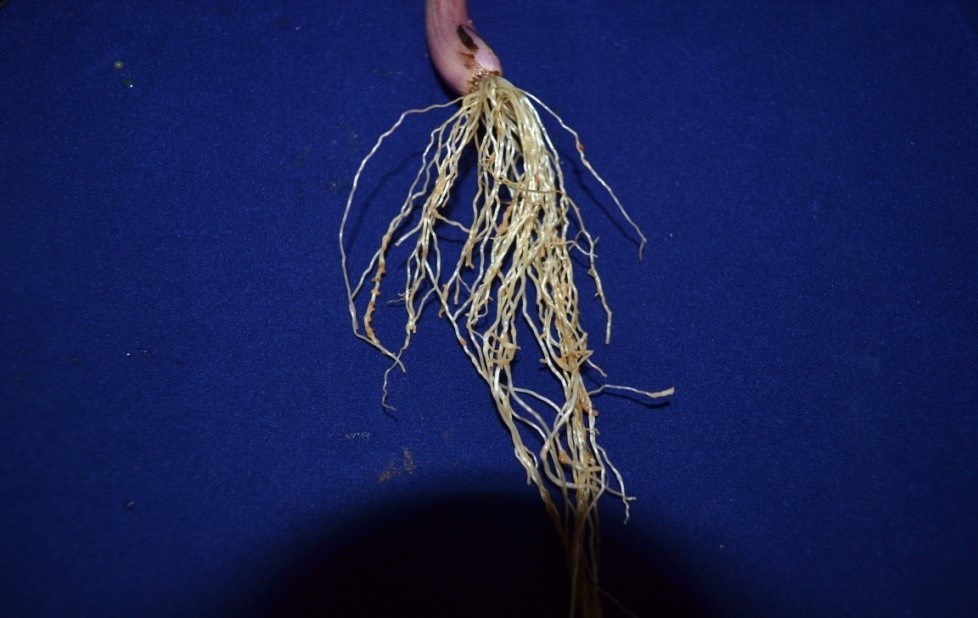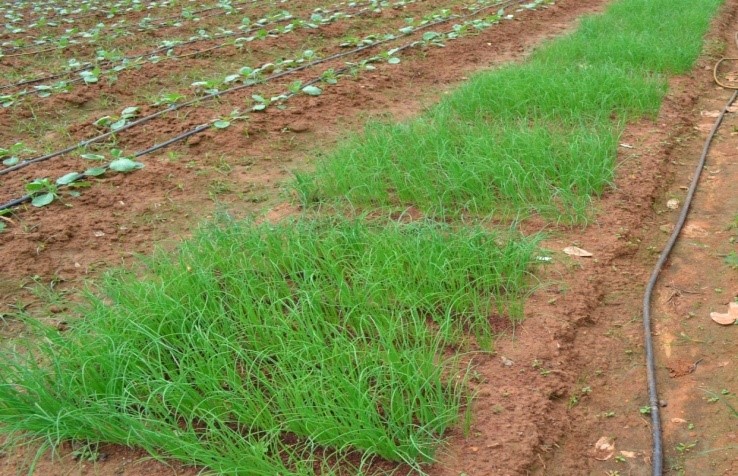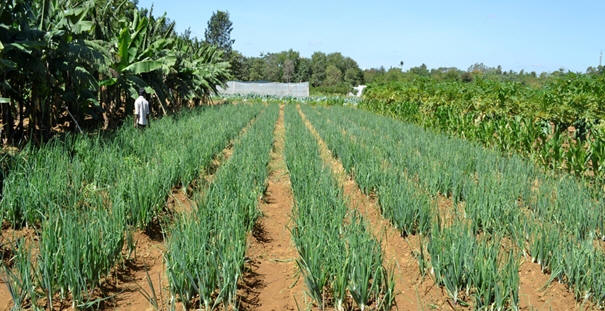
Nematode Management in Onion
The root-knot nematode Meloidogyne incognita is one of the major nematode
pests in onion. Severe infestation causes reduction in onion bulb weight
of 70%. Stunting and galling of roots or thickening of roots are the
symptoms of onions heavily infected with nematodes. Delayed maturity of
bulbs with thicker necks and smaller bulbs are some of the other symptoms.
The nematode is particularly devastating in the seedling stage and amounts
to huge loss at the seedling stage alone. Various incidences of the
root-knot nematode in onion have been reported all over the world.
 |
 |
| Root knot Infected root of
onion |
Onion nursery applied with
biopesticides |
| |
|
Management of nematodes in onion
Application in new planting
Pre-coat seeds with biopesticide before
sowing.
1. Seed treatment.
·
Add biopesticide Pseudomonas fluorescens at
20 ml/kg or 20 g/kg seed.
2. Substrate treatment
Preparation for raising seedlings.
•
For substrate (propagating mixture) used in portrays/polybags mix
biopesticide Pseudomonas fluorescens at 2 g/kg of substrate
(cocopeat/ potting mixture) and fill in portrays/polybags.
•
For nursery beds drench with
3 lit of Pseudomonas fluorescens suspension / m2 (add 5ml
or 5g of formulation / lit of water) before sowing seeds.
3. Bed treatment
Preparation of main field before planting/
transplanting
·
Enrichment of FYM with bio-pesticides: Mix two kg
each of Paecilomyces lilacinus, Pseudomonas fluorescens
and Trichoderma harzianum / T. viride in one ton of FYM and leave it
in shade for 15 days at 25 – 30% moisture for multiplication of beneficial
microbes.
Soil has to be incorporated with 20 – 30 tons of FYM enriched with
bio-pesticides before planting/ transplanting seedlings.
Application in new planting
1. Seed treatment
Pre-coat seeds with biopesticide before sowing.
·
Add biopesticide Pseudomonas fluorescens at
20 ml/kg or 20 g/kg seed.
2. Substrate treatment
Preparation for raising seedlings.
•
For substrate (propagating mixture) used in portrays/polybags mix
biopesticide Pseudomonas fluorescens at 2 g/kg of substrate
(cocopeat/ potting mixture) and fill in portrays/polybags.
•
For nursery beds drench with 3 lit of Pseudomonas fluorescens
suspension / m2 (add 5ml or 5g of formulation / lit of water)
before sowing seeds.
3. Bed treatment
Preparation of main field before planting/
transplanting
·
Enrichment of FYM with bio-pesticides: Mix two kg
each of Paecilomyces lilacinus, Pseudomonas fluorescens
and Trichoderma harzianum / T. viride in one ton of FYM and leave it
in shade for 15 days at 25 – 30% moisture for multiplication of beneficial
microbes.
Soil has to be incorporated with 20 – 30 tons of FYM enriched with
bio-pesticides before planting/ transplanting seedlings.
Application in new planting
1. Seed treatment
Pre-coat seeds with biopesticide before sowing.
·
Add biopesticide Pseudomonas
fluorescens at 20 ml/kg or 20 g/kg seed.
2. Substrate treatment
Preparation for raising seedlings.
•
For substrate (propagating mixture) used in portrays/polybags mix
biopesticide Pseudomonas fluorescens
at 2 g/kg of substrate (cocopeat/ potting mixture) and fill in
portrays/polybags.
•
For nursery beds drench with 3 lit of
Pseudomonas fluorescens
suspension / m2 (add 5ml or 5g of formulation / lit of water)
before sowing seeds.
3. Bed treatment
Preparation of main field before planting/ transplanting
·
Enrichment of FYM with bio-pesticides: Mix two kg each of
Paecilomyces lilacinus,
Pseudomonas fluorescens
and Trichoderma harzianum / T.
viride in one ton of FYM and leave it in shade for 15 days at 25 – 30%
moisture for multiplication of beneficial microbes.
Soil has to be incorporated with 20 – 30 tons of FYM enriched with
bio-pesticides before planting/ transplanting seedlings.
| |
|
 |
 |
| Substrate & nursery bed
treatment with biopesticides
|
Substrate & nursery bed treatment with biopesticides |
Application in standing crop
·
Enrich neem cake with bio-pesticides: Mix two kg of
each of Paecilomyces lilacinus, Pseudomonas fluorescens
and Trichoderma harzianum / T. viride in one ton of neem cake and
leave it in shade for 15 days at 25 – 30% moisture for multiplication of
beneficial microbes.
·
Apply neem cake enriched with biopesticides in
standing crop at 50 g/ m2 once in a month.
Mix 20 kg of enriched neem cake mixture in 200 lit water, leave it
for two days and this can be used for drenching beds @ 2 lit/ m2 or filter
it thoroughly and use it for spraying the foliage or sending along the
drip, once in a month.
 Biopesticides
enriched neem cake suspension
Biopesticides
enriched neem cake suspension
Spray Arka Plant Growth Promoter and Yield
Enhancer (Pseudomonas fluorescens + Trichoderma harzianum) at 5 ml
or 5g/lit, once in a month. Or
send along the drip, Arka Plant Growth Promoter and Yield Enhancer (Pseudomonas
fluorescens + Trichoderma harzianum) at 5 ml or 5g/lit, once in a
month.
Enrichment of biopesticides in FYM/ neem cake

Onion field showcasing the effect of bio-pesticides
Design By :a href="http://www.dreamweaver-templates.org/" target="_blank">Dreamweaver-Templates.org














